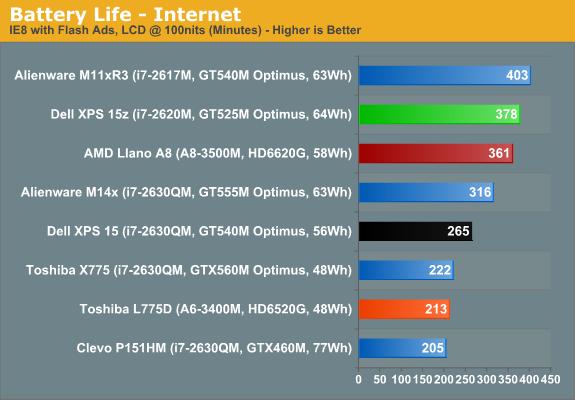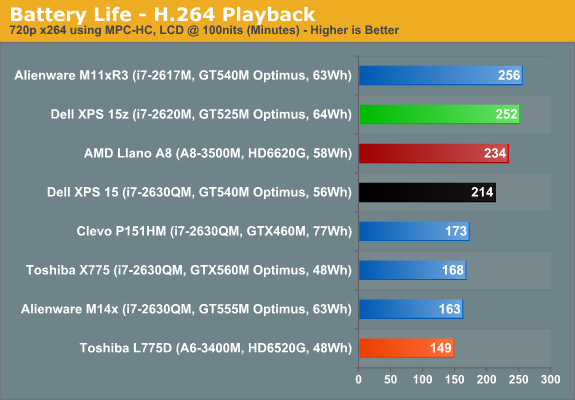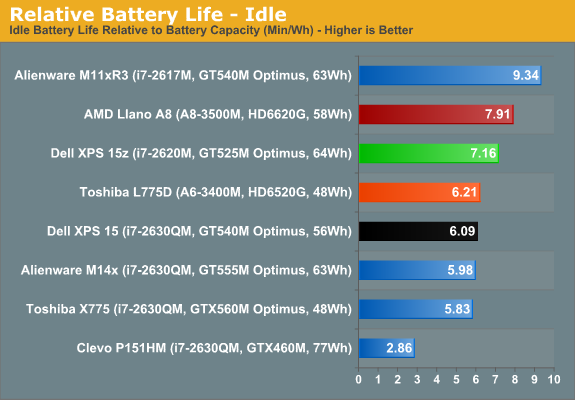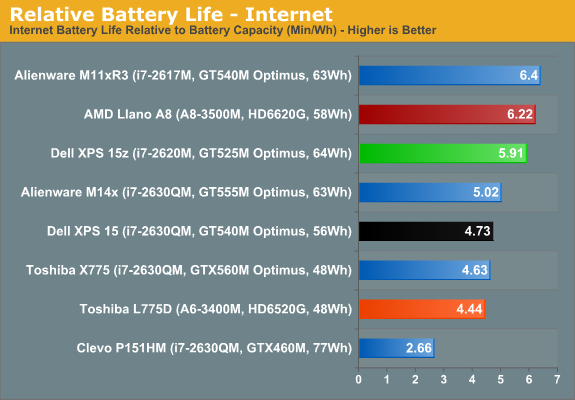Dell XPS 15z: Sincerely Flattering
by Jarred Walton on September 2, 2011 1:30 AM ESTDell XPS 15z Battery Life: Up to 7.5 Hours
It’s interesting to look at battery life for what should otherwise be similar laptops, as the results aren’t always what you’d expect. Consider NVIDIA’s Optimus Technology, which allows the discrete GPU to complete shut off when it’s not in use. Given that the dGPU isn’t using any power in such laptops, in theory we should see consistent relative battery life across all Sandy Bridge (or Second-Generation Core i-series if you prefer the official name) laptops—with dual-core offerings doing somewhat better than quad-core laptops. A look at the results in Mobile Bench however proves that this doesn’t always happen.
ASUS’ K53E uses an i5-2520M and manages 6.43 min/Wh in the Internet test, but the Toshiba M645 only gets 5.23 min/Wh. On the quad-core side of things, the initial Sandy Bridge test laptop got 5.86 min/Wh—a mark yet to be equaled by any shipping SNB quad-core laptops! Alienware’s M14x gets 5.02 min/Wh in the same test while the Dell XPS 15 L502x only scores 4.73 min/Wh (or 4.8 min/Wh with a larger 90Wh battery). There’s certainly variance among the laptops, more than we’d attribute to LCD size or other factors. The question then is where the XPS 15z places, and thankfully it does much better than the XPS 15.






Dell’s XPS 15z not only beats the XPS 15, but it also leads most other Optimus enabled SNB laptops that we’ve tested. The ASUS K53E still wins out for dual-core SNB laptops (it’s not shown in the above charts, but you can see the comparison in Bench), but the only other SNB system to match/exceed the 15z is the Alienware M11x R3—a smaller laptop with a ULV processor. Idle battery life is over 7.5 hours, and if you want to drop the LCD below 100 nits (we tested at 33% brightness), you could probably hit eight hours. For more reasonable use cases, Internet browsing battery life is still an impressive 6+ hours, and H.264 playback from the HDD lasts over four hours.
In terms of modern laptops (e.g. excluding Atom netbooks and older CULV offerings), the only laptops that get better relative battery life than the XPS 15z are equipped with Brazos or Llano, or the already mentioned ASUS K53E and Alienware M11x R3. That puts the 15z in good company as far as operating off the mains is concerned. Of course, if we want to bring OS X into the picture, you’ll still have a hard time matching the 9+ hours the MBP13/15 can reach, but run Windows 7 on a MacBook and you’ll get substantially worse battery life. Unless you want/need more than six hours unplugged time, the XPS 15z should have you covered—at least until your battery starts wearing out and you have to pry open the chassis.










76 Comments
View All Comments
MobiusStrip - Sunday, September 11, 2011 - link
"What is it with people simply lifting the design work of Jonathan Ives for Apple"What is it with people who don't understand that a rectangle with buttons on it isn't the private domain of one company, especially a company that didn't invent the form in the first place?
Do you bitch about every car that has four wheels ripping off the work of some ancient cart-builder?
How about every camera maker that puts the lens of the camera ON THE FRONT, and the viewer on the back?
Plus, your pathetic strawman here doesn't even hold up for superficial similarity. Show us the Apple laptop that has upward-sloping, curved bottom sides?
zepi - Friday, September 2, 2011 - link
You should just take all three Macbook Pro configurations trough your normal Windows-test to give people a measurement stick.A lot of people install Windows to a bootcamp partition to play games that are not released for OSX.
Doing the same with iMac would not hurt either.
Rob Sims - Friday, September 2, 2011 - link
+1Considering how common the 6750m is (the default card in all base model iMacs and also high spec MBP15 and MBP17) there are surprisingly few reliable gaming benchmarks of it.
I run my games through bootcamp on a MBP17 2011 and would be very interested to see how it stacks up to standard windows laptops.
tipoo - Friday, September 2, 2011 - link
+2'ed.darunium - Friday, September 2, 2011 - link
Why the need for a discrete graphics card with intel HD3000 pulling its weight out there? Sure it is no replacement still for a solid discrete solution, so if you want a moderate gaming-capable laptop you still need to look for a separate card, but the GT525M doesn't significantly outperform Intel HD3000 at all, all it will do is add heat, cost, and reduce battery life. It's just another means to sell to an unknowing consumer who will be turned on by the presence of a useless (and now I imagine much-discounted anyway) discrete VGA solution.tipoo - Friday, September 2, 2011 - link
What would be "significantly outperform" to you? If I recall correctly it offers about twice the performance of the HD3000. Besides, the laptop will automatically switch between them anyways, so if your not doing anything intensive it will use the lower power chip.Iketh - Friday, September 2, 2011 - link
aside from what's already mentioned, it also frees up thermal limitations for the cpu and memory bandwidthJarredWalton - Friday, September 2, 2011 - link
Without the dGPU, gaming on the XPS 15z would be a no-go, especially at 1080p. There's a huge difference between 30-40 FPS at 1366x768 at minimum detail (what the HD 3000 can handle) and 30-40 FPS at 1080p and medium detail.seapeople - Saturday, September 3, 2011 - link
As a corollary to the OP's point, I don't understand why they went with Sandy Bridge in this laptop instead of Core 2. Sandy Bridge doesn't significantly outperform Core 2 anyway, so it's just adding heat, cost, and reducing battery life.Brad4 - Friday, September 2, 2011 - link
Low quality monitor. Not good for productivity. I like Windows, but Apple is the only company these days making a 16:10 display laptop. All 16:9 laptops are inferior.